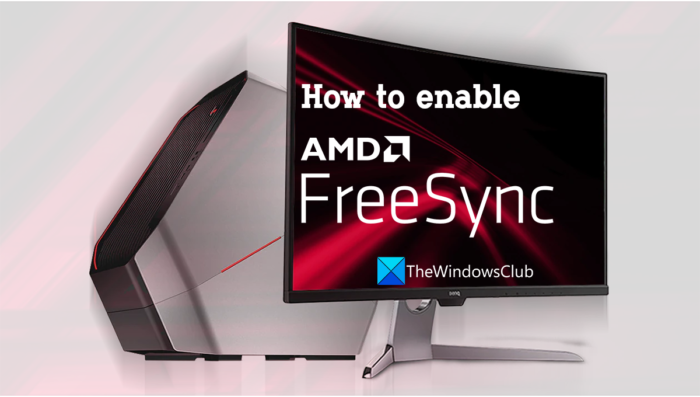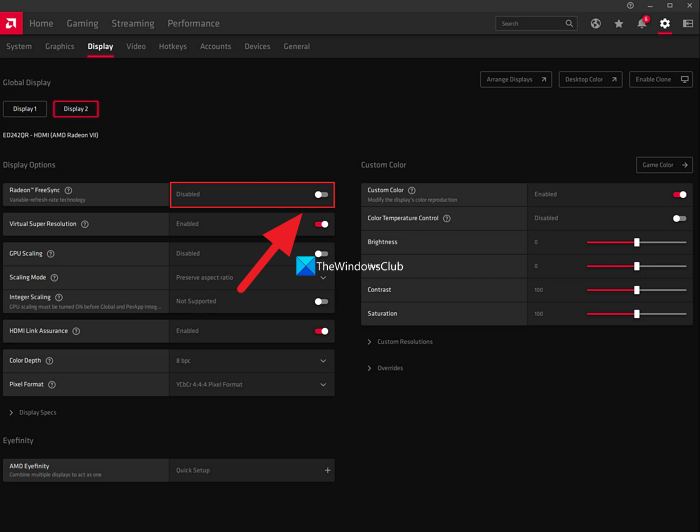AMD FreeSync is a technology designed and developed by AMD that eliminates the stuttering and tearing issues while playing games or watching high-quality videos. Regular tearing and stuttering occur if there is a communication issue between the Graphics Processing Unit and the display. AMD developed AMD FreeSync to eliminate that. In this guide, we show you how to enable AMD FreeSync easily.

Requirements to enable AMD FreeSync
There are certain requirements you need to check if you want to enable AMD FreeSync.
- You need an AMD FreeSync capable monitor, supported AMD Radeon Graphics, or AMD Processor with Radeon Graphics product.
- You also need to have DirectX9 or higher versions installed on your PC as AMD FreeSync currently works with applications using Directx9 or higher versions.
- The display should be AMD FreeSync capable and your need to verify that AMD FreeSync is enabled on display using the On-Screen Display (OSD) controls, also Anti-Blur should be disabled. You also need to have DisplayPort set to 1.2 to higher.
If your monitor or display meets the above requirements, let’s get into the process to enable AMD FreeSync.
How to Enable AMD FreeSync
To enable AMD FreeSync, make sure the AMD Radeon Graphics has the latest drivers installed. AMD FreeSync is enabled by default if the Radeon Software is installed. If by any chance, it is not enabled, follow the below steps.
- Right-click on the desktop and select AMD Radeon Software
- Click on the Gear icon and select Display
- Set AMD FreeSync to enabled
Let’s get into the details of the process.
To get started, right-click on your desktop and select AMD Radeon Software from the context menu. It will open the AMD Radeon Software window. Click on the Gear icon on the top right side of the Window to open Settings. Select Display. Then, select the display that supports AMD FreeSync if you have multiple monitors.
![]()
Once the AMD FreeSync supported display is selected, you will find the Radeon FreeSync option under the Display Options section. Toggle the button beside it to enable the AMD FreeSync.

Close the AMD Radeon Software after enabling the FreeSync. You can disable it the same way you have enabled it.
Read: Fix AMD FreeSync not supported or working on Windows 11/10
You can even customize AMD FreeSync by applications. AMD Radeon Software detects the applications that need AMD FreeSync and lists them in the AMD Radeon Software. You get three options to customize AMD FreeSync per application. They are AMD Optimized, a default option that decides whether the app needs AMD FreeSync or not, On to enable the AMD FreeSync on the application, and Off to Disable the FreeSync on the application.
If you need to customize AMD FreeSync for games, click on the Gaming tab in the AMD Radeon Software. You will see the list of games installed on your PC. Select the game, click on the drop-down button beside Radeon FreeSync under the Display section and select any of the three options, AMD Optimized, On, or Off.
Should I enable AMD FreeSync?
If you play graphic-rich games, watch or work with high-quality videos, and experience stuttering or tearing issues on the display, you should enable it. Even if you do not experience those issues, AMD FreeSync can be enabled for a better display experience.
Read: AMD Radeon software not opening in Windows 11
Is AMD FreeSync automatic?
Yes, AMD FreeSync works automatically. It is even enabled by default if the AMD Radeon Software is installed. It fixes the communication issues with the GPU and your display that cause stuttering or screen tearing issues.
Related read: AMD software stuck on downloading installer update
Leave a Reply